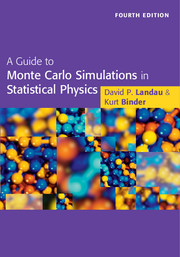Book contents
- Frontmatter
- Contents
- Preface
- 1 Introduction
- 2 Some necessary background
- 3 Simple sampling Monte Carlo methods
- 4 Importance sampling Monte Carlo methods
- 5 More on importance sampling Monte Carlo methods for lattice systems
- 6 Off-lattice models
- 7 Reweighting methods
- 8 Quantum Monte Carlo methods
- 9 Monte Carlo renormalization group methods
- 10 Non-equilibrium and irreversible processes
- 11 Lattice gauge models: a brief introduction
- 12 A brief review of other methods of computer simulation
- 13 Monte Carlo simulations at the periphery of physics and beyond
- 14 Monte Carlo studies of biological molecules
- 15 Outlook
- Appendix: Listing of programs mentioned in the text
- Index
- References
10 - Non-equilibrium and irreversible processes
Published online by Cambridge University Press: 05 November 2014
- Frontmatter
- Contents
- Preface
- 1 Introduction
- 2 Some necessary background
- 3 Simple sampling Monte Carlo methods
- 4 Importance sampling Monte Carlo methods
- 5 More on importance sampling Monte Carlo methods for lattice systems
- 6 Off-lattice models
- 7 Reweighting methods
- 8 Quantum Monte Carlo methods
- 9 Monte Carlo renormalization group methods
- 10 Non-equilibrium and irreversible processes
- 11 Lattice gauge models: a brief introduction
- 12 A brief review of other methods of computer simulation
- 13 Monte Carlo simulations at the periphery of physics and beyond
- 14 Monte Carlo studies of biological molecules
- 15 Outlook
- Appendix: Listing of programs mentioned in the text
- Index
- References
Summary
Introduction and perspective
In the preceding chapters of this book we have dealt extensively with equilibrium properties of a wide variety of models and materials. We have emphasized the importance of insuring that equilibrium has been reached, and we have discussed the manner in which the system may approach the correct distribution of states, i.e. behavior before it comes to equilibrium. This latter topic has been treated from the perspective of helping us understand the difficulties of achieving equilibrium. The theory of equilibrium behavior is well developed and in many cases there is extensive, reliable experimental information available.
In this chapter, however, we shall consider models which are inherently non-equilibrium. This tends to be rather uncharted territory. For some cases theory exists, but it has not been fully tested. In other situations there is essentially no theory to rely upon. In some instances the simulation has preceded the experiment and has really led the way in the development of the field. As in the earlier chapters, for pedagogical reasons we shall concentrate on relatively simple models, but the presentation can be generalized to more complex systems.
- Type
- Chapter
- Information
- A Guide to Monte Carlo Simulations in Statistical Physics , pp. 378 - 407Publisher: Cambridge University PressPrint publication year: 2014

